
Pirámide de Mayo
Encyclopedia
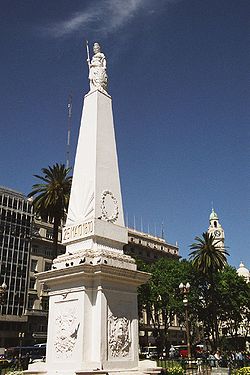
Plaza de Mayo
The Plaza de Mayo is the main square in downtown Buenos Aires, Argentina. It is flanked by Hipólito Yrigoyen, Balcarce, Rivadavia and Bolívar streets....
, is the oldest national monument in the City of Buenos Aires. Its construction was ordered in 1811 by the Primera Junta
Primera Junta
The Primera Junta or First Assembly is the most common name given to the first independent government of Argentina. It was created on 25 May 1810, as a result of the events of the May Revolution. The Junta initially had representatives from only Buenos Aires...
to celebrate the first anniversary of the May Revolution
May Revolution
The May Revolution was a week-long series of events that took place from May 18 to 25, 1810, in Buenos Aires, capital of the Viceroyalty of the Río de la Plata, a Spanish colony that included roughly the territories of present-day Argentina, Bolivia, Paraguay and Uruguay...
. It was renovated in 1856, under the direction of Prilidiano Pueyrredón
Prilidiano Pueyrredón
Prilidiano Pueyrredón was an Argentine painter, architect, and engineer. As one of the country's first prominent painters, he was known for his costumbrist sensibility and preference for everyday themes....
. In 1912, after having undergone numerous modifications, it was moved 63 meters to the east, with the idea that a much larger monument would eventually be constructed around it.
The monument is crowned by an allegory of Liberty
Liberty
Liberty is a moral and political principle, or Right, that identifies the condition in which human beings are able to govern themselves, to behave according to their own free will, and take responsibility for their actions...
, the work of the French sculptor Joseph Dubourdieu. From the ground to the peak of the statue's Phrygian cap
Phrygian cap
The Phrygian cap is a soft conical cap with the top pulled forward, associated in antiquity with the inhabitants of Phrygia, a region of central Anatolia. In the western provinces of the Roman Empire it came to signify freedom and the pursuit of liberty, perhaps through a confusion with the pileus,...
, the Pyramid measures 18.76 meters.
Inauguration
On April 5, 1811, with the approval of the Buenos Aires CabildoBuenos Aires Cabildo
The Buenos Aires Cabildo is the public building in Buenos Aires that was used as seat of the ayuntamiento during the colonial times and the government house of the Viceroyalty of the Río de la Plata...
, it was decided that the program of festivities commemorating the first anniversary of the Revolución de Mayo would include the construction of a pyramid. History does not record why a pyramidal form was chosen for the monument. Some speculate that it was an attempt to emulate the pyramids carved into the pillars of Paris's Porte Saint-Denis
Porte Saint-Denis
The Porte Saint-Denis is a Parisian monument located in the 10th arrondissement, at the site of one of the gates of the Wall of Charles V, one of the now-destroyed fortifications of Paris...
, to which the Pirámide de Mayo bears some resemblance.=
Since 1763 the Plaza de Mayo had been divided by the Recova Vieja (Old Arcade) into two smaller plazas: the one facing the eventual site of the Casa Rosada
Casa Rosada
La Casa Rosada is the official seat of the executive branch of the government of Argentina, and of the offices of the President. The President normally lives at the Quinta de Olivos, a compound in Olivos, Buenos Aires Province. Its characteristic color is pink, and is considered one of the most...
was known as the Plazoleta del Fuerte, and the one facing the Cabildo was known as the Plaza de la Victoria. The pyramid was situated in the center of the latter.
At the insistence of architect Pedro Vicente Cañete and Juan Gaspar Hernández, professor of sculpture at the University of Valladolid
University of Valladolid
The University of Valladolid is a public university in the city of Valladolid, province of Valladolid, in the autonomous region of Castile-Leon, Spain...
, it was decided that the monument would be constructed entirely out of solid materials, including 500 bricks, rather than out of wood, as had been planned originally. On April 6, the cement was poured to form the foundation, amid music and raucous celebration.
.jpg)
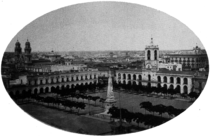
Buenos Aires Metropolitan Cathedral
The Buenos Aires Metropolitan Cathedral is the main Catholic church in Buenos Aires, Argentina. It is located in the city center, overlooking Plaza de Mayo, on the corner of San Martín and Rivadavia streets, in the San Nicolás neighbourhood...
were heavily illuminated. The Recova was illuminated with 1,141 tallow candles. The festivities lasted four days and included dancing, raffles, and the manumission of slaves.
Although Cañete's original plans were lost, studies later determined that the Pyramid had been left hollow, rather than filled with masonry, in order to save time. It was made of baked adobe
Adobe
Adobe is a natural building material made from sand, clay, water, and some kind of fibrous or organic material , which the builders shape into bricks using frames and dry in the sun. Adobe buildings are similar to cob and mudbrick buildings. Adobe structures are extremely durable, and account for...
and stood thirteen meters tall, not including its two meter-tall pedestal. A platform supported its pediment, which was built on top of two grades. It had a simple quadrilateral pedestal and a floating cornice that extended around the entire structure. It was crowned by a decorative globe. The edifice was surrounded by a railing supported by twelve pillars, each terminating in a rounded knob. At each of the fence's four corners was a pointed pole from which lanterns were hung.
On national holidays the Pyramid was decorated with banners, bunting, paper lanterns, and inscriptions.
In 1826 president Bernardino Rivadavia
Bernardino Rivadavia
Bernardino de la Trinidad Gónzalez Rivadavia y Rivadavia was the first president of Argentina, from February 8, 1826 to July 7, 1827 . He was a politician of the United Provinces of Río de la Plata, Argentina today...
announced plans to erect a monument to the Revolución de Mayo which would consist of a magnificent bronze fountain "in place of what exists today". It was debated whether the new monument should replace the Pyramid. In any case, due to Rivadavia's resignation the following year, the project was never carried out, despite the fact that it had been approved by the legislature.
In 1852 the Jaunet brothers illuminated the Pyramid with gas, using a small gasometer
Gasometer
A gas holder is a large container where natural gas or town gas is stored near atmospheric pressure at ambient temperatures. The volume of the container follows the quantity of stored gas, with pressure coming from the weight of a movable cap...
. The public, accustomed to the small oil lanterns, was awestruck by the effect.
The Renovation
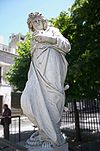
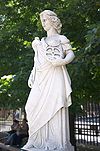
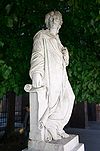
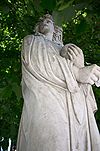
Prilidiano Pueyrredón
Prilidiano Pueyrredón was an Argentine painter, architect, and engineer. As one of the country's first prominent painters, he was known for his costumbrist sensibility and preference for everyday themes....
was charged with the restoration. He set out to transform the monument into something more artistic and grandiose. The modern pyramid was built directly over the old, which was covered in bricks and masonry to form a suitable foundation for the new additions.
The top of the statue was furnished with an allegory of Liberty, crowned with a Phrygian cap
Phrygian cap
The Phrygian cap is a soft conical cap with the top pulled forward, associated in antiquity with the inhabitants of Phrygia, a region of central Anatolia. In the western provinces of the Roman Empire it came to signify freedom and the pursuit of liberty, perhaps through a confusion with the pileus,...
. This statue, standing 3.6 meters, was created by the French sculptor Joseph Dubourdieu from a combination of materials. Dubourdieu was also responsible for four other allegories, Industry, Commerce, The Sciences and The Arts, which were placed at the four corners of the pedestal.
The eastern face of the obelisk was adorned with a golden sun, which now faces toward the Casa Rosada
Casa Rosada
La Casa Rosada is the official seat of the executive branch of the government of Argentina, and of the offices of the President. The President normally lives at the Quinta de Olivos, a compound in Olivos, Buenos Aires Province. Its characteristic color is pink, and is considered one of the most...
. The remaining three sides are decorated with crowns of laurels in alto-relievo. Pueyrredón also modified the original pedestal and capital, increasing their height and breadth. Each of the four sides of the base was adorned with the national arms
Coat of arms of Argentina
The coat of arms of Argentina was established in its current form in 1944, but has its origins in the seal of the General Constituent Assembly of 1813. It is supposed that it was chosen quickly because of the existence of a decree signed on February 22 sealed with the symbol...
. A new fence was constructed and a gaslight placed at each corner.
In 1859, the deteriorating condition of the plaster led the city to reface the base in marble.
By 1873 the stucco and terracotta statues installed by Dubourdieu had not surprisingly begun to decay. Consequently, they were replaced with four Carrara
Carrara
Carrara is a city and comune in the province of Massa-Carrara , notable for the white or blue-grey marble quarried there. It is on the Carrione River, some west-northwest of Florence....
marble statues which had originally been located on the first floor of the Banco Provincia on Calle San Martín. These were Geography, Astronomy, Navigation and Industry. These remained until 1912, when they were placed in storage. In 1972 they were installed — and remain to this day — in the old Plazoleta de San Francisco, at the intersection of Calles Defensa and Alsina, 150 meters from the modern Pyramid.
In 1883, on the orders of president Marcelo Torcuato de Alvear
Marcelo Torcuato de Alvear
Máximo Marcelo Torcuato de Alvear Pacheco , better known as Marcelo T. de Alvear was an Argentine politician and President of Argentina from October 12, 1922 to October 12, 1928.-Biography:...
, the Recova was demolished, joining the Plazoleta del Fuerte and the Plaza del Victoria to form the modern Plaza de Mayo
Plaza de Mayo
The Plaza de Mayo is the main square in downtown Buenos Aires, Argentina. It is flanked by Hipólito Yrigoyen, Balcarce, Rivadavia and Bolívar streets....
. Alvear had considered demolishing the Pyramid and erecting a more grandiose monument in its place, but in order to do so, required the permission of the deliberative council in charge of the project. The council consulted the opinion of various distinguished citizens, including ex-presidents Bartolomé Mitre
Bartolomé Mitre
Bartolomé Mitre Martínez was an Argentine statesman, military figure, and author. He was the President of Argentina from 1862 to 1868.-Life and times:...
, Domingo Faustino Sarmiento
Domingo Faustino Sarmiento
Domingo Faustino Sarmiento was an Argentine activist, intellectual, writer, statesman and the seventh President of Argentina. His writing spanned a wide range of genres and topics, from journalism to autobiography, to political philosophy and history...
, and Nicolás Avellaneda
Nicolás Avellaneda
Nicolás Remigio Aurelio Avellaneda Silva was an Argentine politician and journalist, and president of Argentina from 1874 to 1880. Avellaneda's main projects while in office were banking and education reform, leading to Argentina's economic growth...
. Mitre saw no reason to preserve the monument, because after its many renovations and additions it was no longer, in an authentic sense, the original Pyramid erected following the Revolution. He considered only the foundation worthy of preservation. Sarmiento also rejected the additions to the primitive structure. Avellaneda felt it should be restored to its original form and stripped of its more recent adornments, but not destroyed outright. In the end, none of these suggestions were acted upon, because although the majority favored demolition, the national government preferred the status quo.
The Relocation
In 1906, with a few years until the centenary of the May Revolution, plans were put forward for a new monument that would completely contain the Pyramid, which consequently had to be relocated to the center of the Plaza de Mayo. This was not realized until 1912. After the marble statues had been removed, the Pyramid was enclosed with wood for protection. Two rails were laid, four meters apart, supported by masonry pillars that could support a weight of 225 metric tons. Under the Pyramid was a cement platform resting on solid wheels. Between the 12th and 20 November, the Pyramid was pulled 63.17 meters with a winch. A metal time capsuleTime capsule
A time capsule is an historic cache of goods or information, usually intended as a method of communication with future people and to help future archaeologists, anthropologists, or historians...
containing information about the relocation was buried under the Pyramid's new foundation.
Despite the success of the move, the project to surround the Pyramid with a larger monument never materialized. Many remained hopeful that the Pyramid would be restored to its historical origins, including the return of the steps and railing, and the removal of the "shell of stucco and inappropriate figures". However, later resolutions limited further reforms to ground level. The foundation was repainted and the arms restored to their 1813 condition. The original railing was, ultimately, restored.
Decree 120.412, issued May 21, 1942, declared the Pyramid a historical monument. Law 1.653, passed by the legislature of the city of Buenos Aires on March 10, 2005, conferred the status of a historical site on the area surrounding the Pyramid, which is notable for sidewalk paintings of shawls representing the Madres de Plaza de Mayo. On December 8 of that year, at the request of her children, the ashes of the organization's founder, Azucena Villaflor
Azucena Villaflor
Azucena Villaflor was an Argentine social activist, and one of the founders of the human rights association called Mothers of the Plaza de Mayo, which looked for desaparecidos .Villaflor was the daughter of a lower class family, and her mother, Emma Nitz, was only 15...
, were buried at the base of the Pyramid, where she had organized her first protest.
The Commemorative Plaque
On the west side of the Pyramid is a bronze plaque, 85 cm wide and 57 cm high, on which two names are inscribed: Felipe Pereyra de Lucena and Manuel Artigas. These names, unknown to most who visit the Pyramid, were added to the monument in 1891 during the presidency of Carlos PellegriniCarlos Pellegrini
Carlos Enrique José Pellegrini Bevans was President of Argentina from 6 August 1890 to 12 October 1892....
, in recognition of the first two military officers to lose their lives in the cause of Argentine independence:
- Manuel Artigas was the brother of José Gervasio ArtigasJosé Gervasio ArtigasJosé Gervasio Artigas is a national hero of Uruguay, sometimes called "the father of Uruguayan nationhood".-Early life:Artigas was born in Montevideo on June 19, 1764...
, the caudillo of the Banda Oriental, which was later to become UruguayUruguayUruguay ,officially the Oriental Republic of Uruguay,sometimes the Eastern Republic of Uruguay; ) is a country in the southeastern part of South America. It is home to some 3.5 million people, of whom 1.8 million live in the capital Montevideo and its metropolitan area...
. Born in MontevideoMontevideoMontevideo is the largest city, the capital, and the chief port of Uruguay. The settlement was established in 1726 by Bruno Mauricio de Zabala, as a strategic move amidst a Spanish-Portuguese dispute over the platine region, and as a counter to the Portuguese colony at Colonia del Sacramento...
in 1774, Manuel Artigas belonged to a revolutionary group which also included Domingo FrenchDomingo FrenchDomingo French was an Argentine revolutionary who took part in the May Revolution and the Argentine War of Independence.- Biography :...
and Antonio BerutiAntonio BerutiAntonio Luis Beruti was an Argentine revolutionary who participated in the May Revolution that started the Argentine War of Independence, and later fought in the Argentine civil wars....
. He distinguished himself during the Paraguayan campaign of 1811, and was noted for his heroism at the Battle of CampichueloBattle of CampichueloThe Battle of Campichuelo was a battle fought on 19 December 1810 between revolutionary forces led by Manuel Belgrano and Royalist troops on the right bank of the Paraná river, as part of the Paraguay campaign of the Argentine War of Independence...
. He was wounded on April 25 and died May 24 at the age of 33.
- Felipe Pereyra de Lucena was born in 1789 and served as a cadet during the British invasions of the Río de la PlataBritish invasions of the Río de la PlataThe British invasions of the Río de la Plata were a series of unsuccessful British attempts to seize control of the Spanish colonies located around the La Plata Basin in South America . The invasions took place between 1806 and 1807, as part of the Napoleonic Wars, when Spain was an ally of...
. By the May Revolution he was already a lieutenant, having attained this rank during the campaign of Upper PeruUpper PeruUpper Peru was the region in the Viceroyalty of Peru, and after 1776, the Viceroyalty of the Río de la Plata, comprising the governorships of Potosí, La Paz, Cochabamba, Los Chiquitos, Moxos and Charcas...
. In 1811 he was promoted to captain. He was wounded in what is today BoliviaBoliviaBolivia officially known as Plurinational State of Bolivia , is a landlocked country in central South America. It is the poorest country in South America...
and transported to the settlement of Jesús Machaca, where he died on June 20 at the age of 22.
The news of these two casualties was met with shock, in response to which the government junta resolved to record the officers' names in bronze. However, due to lack of funds, the project was suspended. Pereyra's father petitioned the government in 1812, to no avail. In 1856, relatives of Pereyra once more appealed for the plaque's creation, but no action was taken. In 1891, the necessary funds were raised through popular subscription, and the plaque was installed on May 24 of that year.

